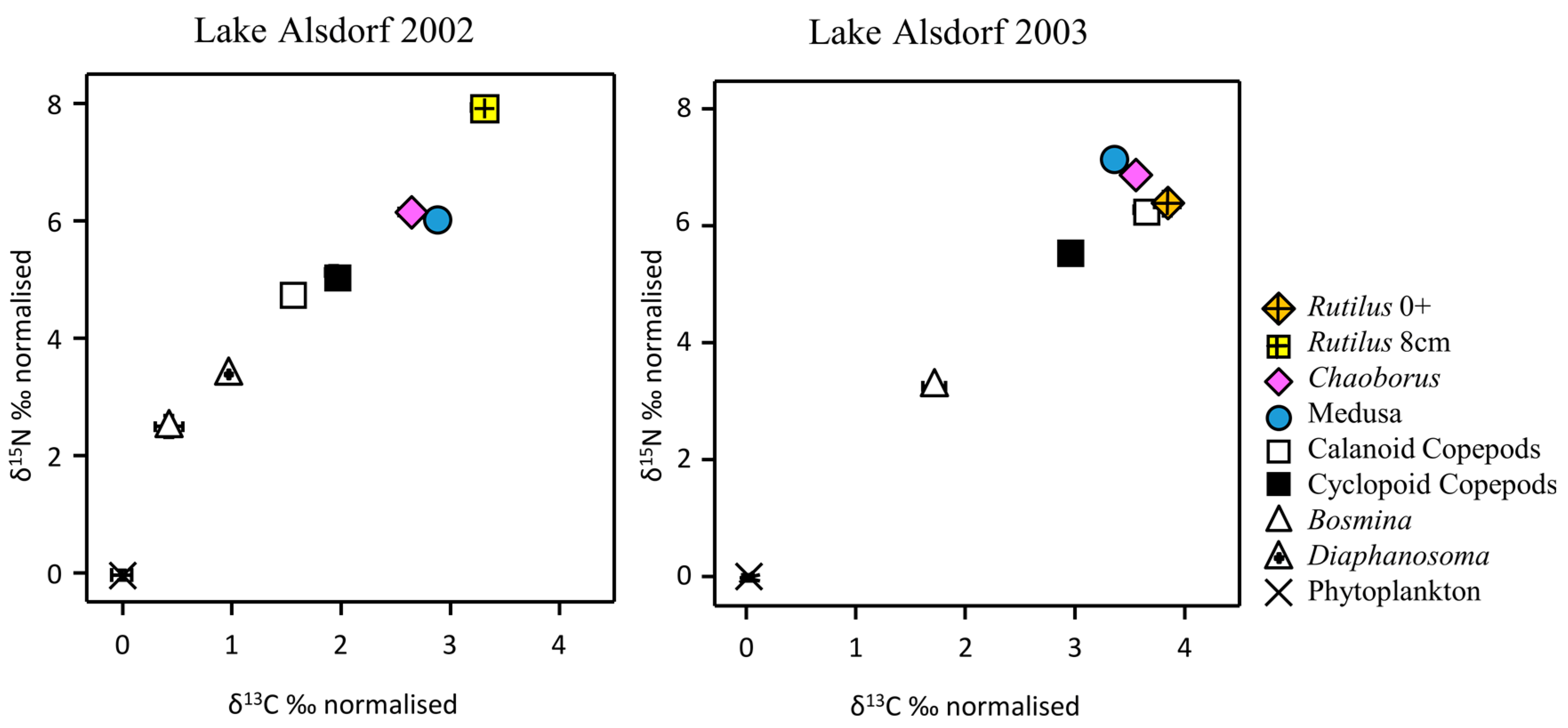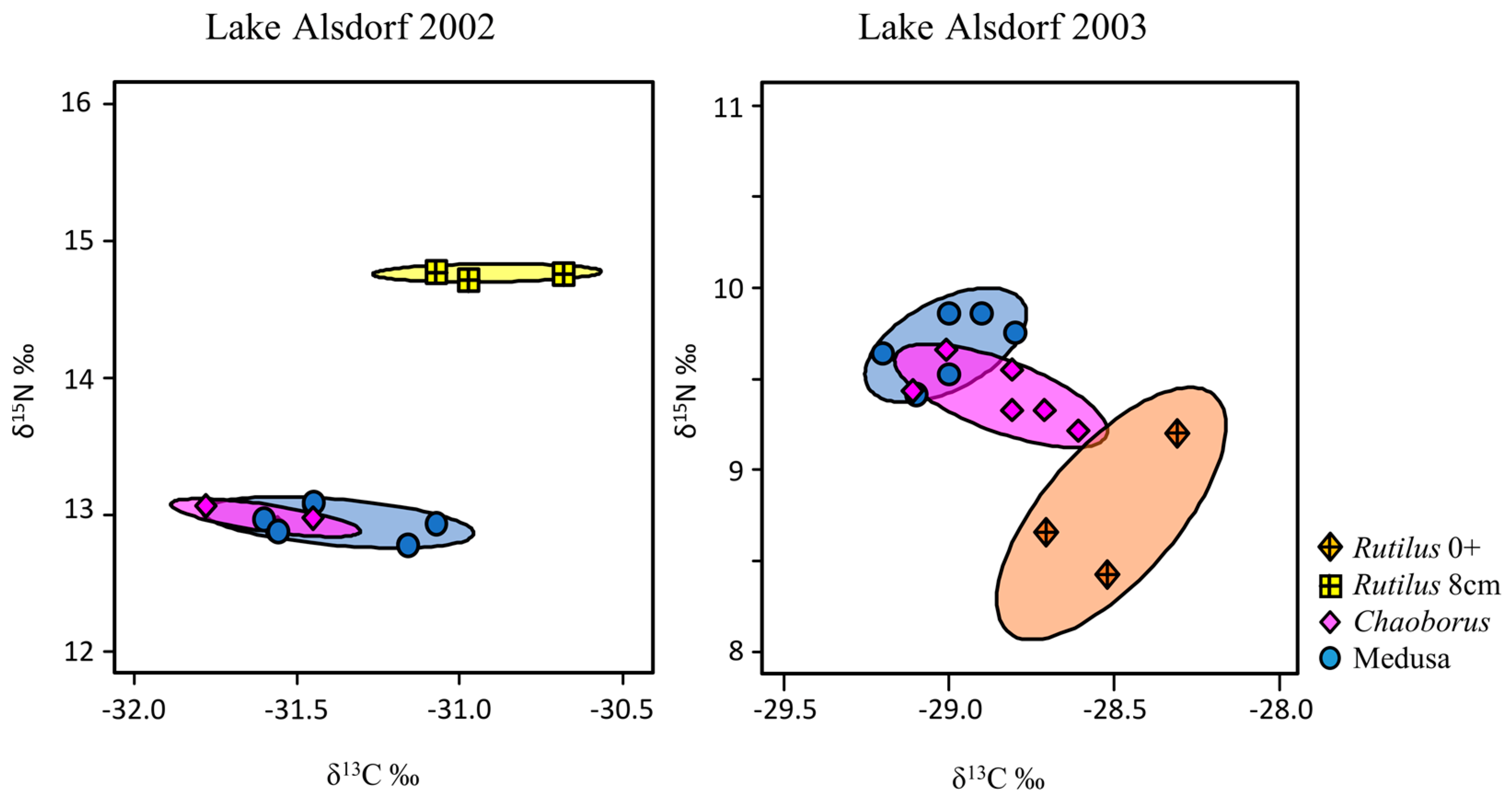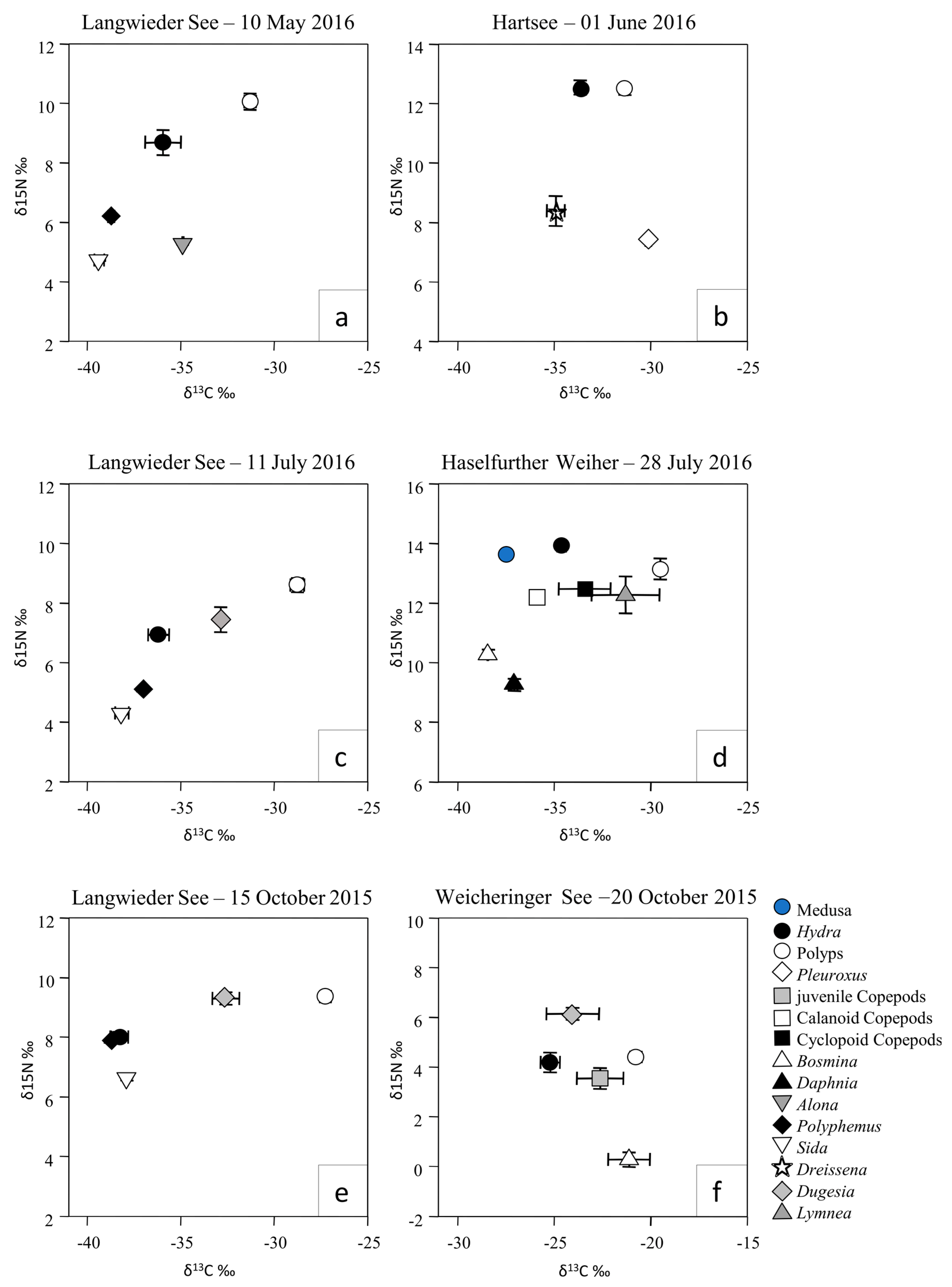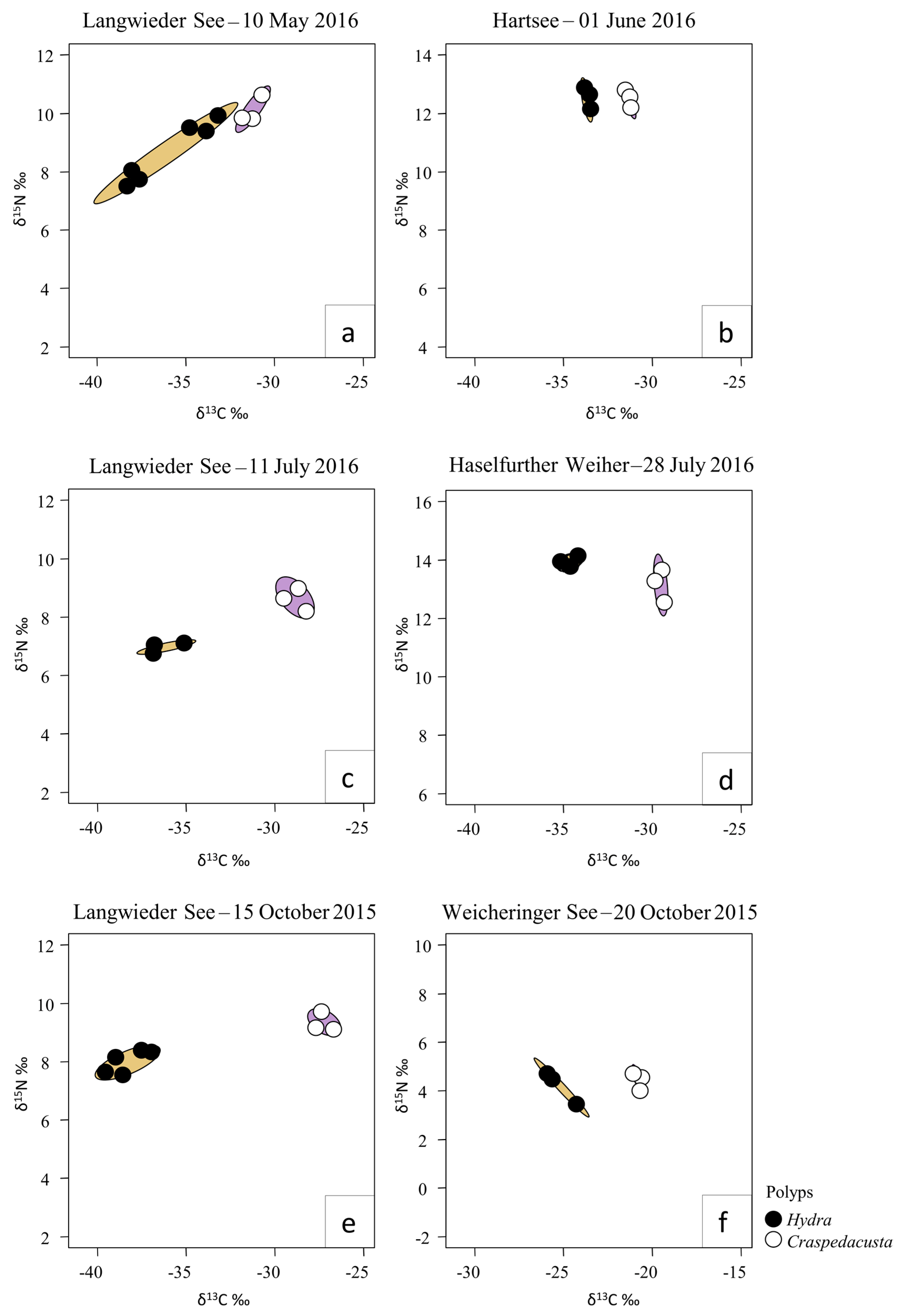Trophic Positions of Polyp and Medusa Stages of the Freshwater Jellyfish Craspedacusta sowerbii Based on Stable Isotope Analysis
Abstract
Simple Summary
Abstract
1. Introduction
2. Materials and Methods
2.1. Sampling and Sample Preparation for Pelagic Food-Web Analysis
2.2. Sampling and Sample Preparation for Benthic Food-Web Analysis
2.3. Stable Isotope Analysis
2.4. Statistical Analysis
3. Results
3.1. Isotopic Niche Differentiation of Craspedacusta Medusae, Chaoborus Larvae, and Fish Larvae
3.2. Isotopic Niche Differentiation of Craspedacusta and Hydra Polyps
4. Discussion
4.1. Trophic Position of Craspedacusta Medusae
4.2. Isotopic Niche Differentiation of Craspedacusta Polyps
4.3. Trophic Niches in the Metagenetic Life Cycle of Craspedacusta
5. Conclusions
Author Contributions
Funding
Institutional Review Board Statement
Informed Consent Statement
Data Availability Statement
Acknowledgments
Conflicts of Interest
Appendix A
| Lake Alsdorf | Lake Hartsee | Lake Haselfurther Weiher | Lake Langwieder See | Lake Weicheringer See | |
|---|---|---|---|---|---|
| Latitude | 50.8626 | 47.9268 | 48.4820 | 48.1969 | 48.7036 |
| Longitude | 6.1531 | 12.3671 | 12.0130 | 11.4166 | 11.3296 |
| Max. depth (m) | 4.1 | 39.1 | 5.2 | 8.7 | 5.0 |
| Area (m2) | 31,000 | 860,000 | 70,500 | 184,000 | 180,000 |
| TP (µg L−1) | 164 ± 36 a | 13.58 | 8.48 | 8.20 | 11.88 |
| Lake type | pond | natural lake | quarry pond | quarry pond (since 1930) | quarry pond (since 1965) |
| Sampling dates | (1) 30 July 2002 | ||||
| (2) 02 August 2002 | |||||
| (3) 05 August 2002 | 1 June 2016 | 28 July 2016 | (1) 15 October 2015 | 20 October 2015 | |
| (4) 15 July 2003 | (2) 10 May 2016 | ||||
| (5) 18 July 2003 | (3) 11 July 2016 | ||||
| (6) 21 July 2003 | |||||
| (7) 26 July 2003 | |||||
| Sampled invertebrate taxa and fish | Phytoplankton (3,6) | Craspedacusta Polyps | Craspedacusta Polyps | Craspedacusta Polyps (1,2,3) | Craspedacusta Polyps |
| Bosmina longirostris (3,7) | Hydra Polyps | Hydra Polyps | Hydra Polyps (1,2,3) | Hydra Polyps | |
| Diaphanosoma brachyurum (3) | Pleuroxus truncatus | Bosmina sp. | Alona sp. (2) | Bosmina sp. | |
| Eudiaptomus gracilis (3,6,7) | Dreissena polymorpha | Daphnia longispina | Polyphemus pediculus(1,2,3) | Calanoid and cyclopoid copepods | |
| Cyclopoid copepods (3,6,7) | Calanoid copepods | Sida crystallina (1,2,3) | Dugesia sp. | ||
| Chironomid larvae (3,6) | Cyclopoid copepods | Dugesia sp. (1,3) | |||
| Craspedacusta sowerbii Medusae (1,2,4,5) | Lymnea stagnalis | ||||
| Chaoborus flavicans(3,6) | Craspedacusta Medusa | ||||
| Rutilus rutilus 8 cm (3) | |||||
| Rutilus rutilus 0+ (7) |
| Taxon | Year | N | δ13C ‰ | δ15N ‰ |
|---|---|---|---|---|
| Bosmina | 2002 | 4 | −33.80 ± 0.13 | 9.33 ± 0.18 |
| Calanoida (adult) | 2002 | 2 | −32.72 ± 0.03 | 11.65 ± 0.04 |
| Chaoborus | 2002 | 3 | −31.60 ± 0.10 | 12.98 ± 0.04 |
| Chironomid larvae | 2002 | 3 | −33.82 ± 0.11 | 6.79 ± 0.05 |
| Craspedacusta Medusae | 2002 | 5 | −31.37 ± 0.11 | 12.94 ± 0.04 |
| Cyclopoida (adult) | 2002 | 4 | −32.30 ± 0.07 | 11.95 ± 0.11 |
| Diaphanosoma | 2002 | 2 | −33.27 ± 0.04 | 10.26 ± 0.02 |
| Phytoplankton | 2002 | 5 | −34.22 ± 0.10 | 6.83 ± 0.06 |
| Rutilus 8 cm | 2002 | 3 | −30.92 ± 0.12 | 14.76 ± 0.02 |
| Bosmina | 2003 | 4 | −30.63 ± 0.10 | 5.88 ± 0.03 |
| Calanoida (adult) | 2003 | 4 | −28.73 ± 0.08 | 8.90 ± 0.15 |
| Chaoborus | 2003 | 6 | −28.83 ± 0.08 | 9.58 ± 0.06 |
| Chironomid larvae | 2002 | 3 | −30.33 ± 0.15 | 5.27 ± 0.07 |
| Craspedacusta Medusae | 2003 | 6 | −29.00 ± 0.06 | 9.83 ± 0.07 |
| Cyclopoida (adult) | 2003 | 4 | −29.40 ± 0.04 | 8.20 ± 0.15 |
| Phytoplankton | 2003 | 5 | −32.34 ± 0.06 | 2.60 ± 0.05 |
| Rutilus 0+ | 2003 | 3 | −28.50 ± 0.12 | 9.00 ± 0.21 |
| δ13C ‰ | δ15N ‰ | ||||||
|---|---|---|---|---|---|---|---|
| Lake | Date | Craspedacusta | Hydra | p | Craspedacusta | Hydra | p |
| Langwieder See | 10 May 2016 | −31.3 ± 0.3 | −36.0 ± 0.9 | 0.024 | 10.1 ± 0.3 | 8.7 ± 0.4 | 0.069 |
| 11 July 2016 | −28.8 ± 0.4 | −36.2 ± 0.6 | <0.001 | 8.6 ± 0.2 | 6.9 ± 0.1 | 0.002 | |
| 15 October 2015 | −27.3 ± 0.3 | −38.3 ± 0.5 | <0.001 | 9.4 ± 0.2 | 8.0 ± 0.2 | 0.002 | |
| Hartsee | 1 June 2016 | −31.3 ± 0.1 | −33.6 ± 0.1 | <0.001 | 12.5 ± 0.2 | 12.5 ± 0.2 | 0.825 |
| Haselfurther Weiher | 28 July 2016 | −29.5 ± 0.1 | −34.6 ± 0.2 | <0.001 | 13.1 ± 0.4 | 13.9 ± 0.1 | 0.100 |
| Weicheringer See | 20 October 2015 | −20.8 ± 0.1 | −25.2 ± 0.5 | <0.001 | 4.4 ± 0.2 | 4.2 ± 0.4 | 0.636 |
References
- Lankester, E.R. On a new jelly-fish of the order Trachomedusae, living in fresh water. Science 1880, os-1, 34. [Google Scholar] [CrossRef]
- Kramp, P.L. Freshwater medusae in China. Proc. Zool. Soc. Lond. 1950, 120, 165–184. [Google Scholar] [CrossRef]
- Dumont, H.J. The distribution and ecology of the fresh-and brackish-water medusae of the world. Hydrobiologia 1994, 272, 1–12. [Google Scholar] [CrossRef]
- Jankowski, T. The freshwater medusae of the world—A taxonomic and systematic literature study with some remarks on other inland water jellyfish. Hydrobiologia 2001, 462, 91–113. [Google Scholar] [CrossRef]
- Jankowski, T.; Collins, A.G.; Campbell, R. Global diversity of inland water cnidarians. In Freshwater Animal Diversity Assessment; Springer: Dordrecht, The Netherlands, 2008; Volume 595, pp. 35–40. [Google Scholar]
- Duggan, I.C.; Eastwood, K.R. Detection and distribution of Craspedacusta sowerbii: Observations of medusae are not enough. Aquat. Invasions 2012, 7, 271–275. [Google Scholar] [CrossRef]
- Väinölä, R. Lammikkomeduusa Craspedacusta sowerbii Suomessa: The freshwater jellyfish Craspedacusta sowerbii in Finland. Memo. Soc. Pro Fauna Flora Fenn. 2002, 78, 13–15. [Google Scholar]
- Arbačiauskas, K.; Lesutienė, J. The freshwater jellyfish (Craspedacusta sowerbii) in Lithuanian waters. Acta Zool. Litu. 2005, 15, 54–57. [Google Scholar] [CrossRef]
- Pérez-Bote, J.L.; Muñoz, A.; Morán, R.; Roso, R.; Romero, A.J. First record of Craspedacusta sowerbyi Lankester, 1880 (Cnidaria: Limnomedusae: Olindiidae) in the Proserpina Reservoir (Extremadura, SW Spain) with notes on their feeding habits. Belg. J. Zool. 2006, 136, 163. [Google Scholar]
- Saadalla, H.A.A. First record of the freshwater medusa Craspedacusta sp.(Cnidaria, Hydrozoa) from an artificial lake in Baghdad, Iraq. Zool. Middle East 2006, 37, 107–110. [Google Scholar] [CrossRef]
- Stefani, F.; Leoni, B.; Marieni, A.; Garibaldi, L. A new record of Craspedacusta sowerbii, Lankester 1880 (Cnidaria, Limnomedusae) in northern Italy. J. Limnol. 2010, 69, 189. [Google Scholar] [CrossRef]
- Gasith, A.; Gafny, S.; Hershkovitz, Y.; Goldstein, H.; Galil, B.S. The invasive freshwater medusa Craspedacusta sowerbii lankester, 1880 (Hydrozoa: Olindiidae) in Israel. Aquat. Invasions 2011, 6, S147–S152. [Google Scholar] [CrossRef]
- Raposeiro, P.M.; Ramos, J.; Costa, A.C. First Record of Craspedacusta sowerbii Lankester, 1880 (Cnidaria: Limnomedusae) in the Azores. Arquipel.-Life Mar. Sci. 2011, 28, 11–13. [Google Scholar]
- Galarce, L.C.; Riquelme, K.V.; Osman, D.Y.; Fuentes, R.A. A new record of the non indigenous freshwater jellyfish Craspedacusta sowerbii Lankester, 1880 (Cnidaria) in Northern Patagonia (40 S, Chile). BioInvasions Rec. 2013, 2, 263–270. [Google Scholar] [CrossRef]
- Gomes-Pereira, J.N.; Dionísio, G. Craspedacusta sowerbii Lankester, 1880 in southern Portugal. BioInvasions Rec. 2013, 2, 133–136. [Google Scholar] [CrossRef]
- Karaouzas, I.; Zogaris, S.; Lopes-Lima, M.; Froufe, E.; Varandas, S.; Teixeira, A.; Sousa, R. First record of the freshwater jellyfish Craspedacusta sowerbii Lankester, 1880 in Greece suggests distinct European invasion events. Limnology 2015, 16, 171–177. [Google Scholar] [CrossRef]
- Lüskow, F.; López-González, P.J.; Pakhomov, E.A. Freshwater jellyfish in northern temperate lakes: Craspedacusta sowerbii in British Columbia, Canada. Aquat. Biol. 2021, 30, 69–84. [Google Scholar] [CrossRef]
- Marchessaux, G.; Luskow, F.; Sara, G.; Pakhomov, E.A. Predicting the current and future global distribution of the invasive freshwater hydrozoan Craspedacusta sowerbii. Sci. Rep. 2021, 11, 23099. [Google Scholar] [CrossRef] [PubMed]
- Hutchinson, G. 1957: Concluding remarks. Cold Spring Harb. Symp. Quant. Biol. 1957, 22, 415–427. [Google Scholar] [CrossRef]
- Elith, J. Predicting distributions of invasive species. In Invasive species: Risk assessment and management; Cambridge University Press: Cambridge, UK, 2017; pp. 93–129. [Google Scholar]
- Buchberger, F.; Stockenreiter, M. Unsuccessful invaders structure a natural freshwater phytoplankton community. Ecosphere 2018, 9, e02158. [Google Scholar] [CrossRef]
- MacArthur, R.; Levins, R. The limiting similarity, convergence, and divergence of coexisting species. Am. Nat. 1967, 101, 377–385. [Google Scholar] [CrossRef]
- Page, B.; McKenzie, J.; Goldsworthy, S.D. Dietary resource partitioning among sympatric New Zealand and Australian fur seals. Mar. Ecol. Prog. Ser. 2005, 293, 283–302. [Google Scholar] [CrossRef]
- Leyequién, E.; de Boer, W.F.; Cleef, A. Influence of body size on coexistence of bird species. Ecol. Res. 2007, 22, 735–741. [Google Scholar] [CrossRef]
- Kotler, B.P.; Brown, J.S.; Subach, A. Mechanisms of species coexistence of optimal foragers: Temporal partitioning by two species of sand dune gerbils. Oikos 1993, 67, 548–556. [Google Scholar] [CrossRef]
- Acker, T.S.; Muscat, A.M. The ecology of Craspedacusta sowerbii Lankester, a freshwater hydrozoan. Am. Midl. Nat. 1976, 95, 323–336. [Google Scholar] [CrossRef]
- Reisinger, E. Süßwassermedusen (Limnomedusae = Limnotrachylina). Das Zooplankton Der Binnengewässer 1972, 1, 85–97. [Google Scholar]
- Lundberg, S.; Svensson, J.-E.; Petrusek, A. Craspedacusta invasions in Sweden. Int. Ver. Theor. Angew. Limnol. Verh. 2005, 29, 899–902. [Google Scholar] [CrossRef]
- Quinn, B.; Gagné, F.; Blaise, C. Hydra, a model system for environmental studies. Int. J. Dev. Biol. 2012, 56, 613–625. [Google Scholar] [CrossRef]
- Folino-Rorem, N.C. Chapter 9—Phylum Cnidaria. In Thorp and Covich’s Freshwater Invertebrates, 4th ed.; Thorp, J.H., Rogers, D.C., Eds.; Academic Press: Boston, MA, USA, 2015; pp. 159–179. [Google Scholar]
- Martínez, D.; Iñiguez, A.; Percell, K.; Willner, J.; Signorovitch, J.; Campbell, R. Phylogeny and biogeography of Hydra (Cnidaria: Hydridae) using mitochondrial and nuclear DNA sequences. Mol. Phylogenetics Evol. 2010, 57, 403–410. [Google Scholar] [CrossRef]
- Schuchert, P. The European athecate hydroids and their medusae (Hydrozoa, Cnidaria): Capitata part 2. Rev. Suisse Zool. 2010, 117, 337–555. [Google Scholar] [CrossRef]
- Hyman, L.H. The Invertebrates: Protozoa through Ctenophora; McGrawHill Book Companies: New York, NY, USA, 1940; Volume 1, p. 726. [Google Scholar]
- Dejdar, E. Die Süßwassermeduse Craspedacusta sowerbii Lankester in monographischer Darstellung. Z. Morphol. Ökologie Der Tiere 1934, 28, 595–691. [Google Scholar] [CrossRef]
- Dunham, D.W. Studies on the Ecology and Physiology of the Freshwater Jellyfish, Craspedacusta sowerbii. Ph.D. thesis, Ohio State University, Columbus, OH, USA, 1941. [Google Scholar]
- Folino-Rorem, N.; Stoeckel, J.; Thorn, E.; Page, L. Effects of artificial filamentous substrate on zebra mussel (Dreissena polymorpha) settlement. Biol. Invasions 2006, 8, 89–96. [Google Scholar] [CrossRef]
- Massaro, F.C.; Negreiros, N.F.; Rocha, O. A search for predators and food selectivity of two native species of Hydra (Cnidaria: Hydrozoa) from Brazil. Biota Neotrop. 2013, 13, 35–40. [Google Scholar] [CrossRef]
- McClary, A. The effect of temperature on growth and reproduction in Craspedacusta sowerbii. Ecology 1959, 40, 158–162. [Google Scholar] [CrossRef]
- Rivera-De la Parra, L.; Sarma, S.; Nandini, S. Effects of predation by Hydra (Cnidaria) on cladocerans (Crustacea: Cladocera). J. Limnol. 2016, 75, 39–47. [Google Scholar] [CrossRef]
- Walsh, E.J.; Salazar, M.; Remirez, J.; Moldes, O.; Wallace, R.L. Predation by invertebrate predators on the colonial rotifer Sinantherina socialis. Invertebr. Biol. 2006, 125, 325–335. [Google Scholar] [CrossRef]
- Gause, G.F. Experimental analysis of Vito Volterra’s mathematical theory of the struggle for existence. Science 1934, 79, 16–17. [Google Scholar] [CrossRef]
- Dodds, R.B.; Hall, K.D. Environmental and Physiological Studies of the Freshwater Jellyfish Craspedacusta Sowerbyi. Bios 1984, 55, 75–83. [Google Scholar]
- Koetsier, P.; Bryan, C.F. Winter and spring macroinvertebrate drift in an outpocketing of the lower Mississippi River, Louisiana (USA). Hydrobiologia 1989, 185, 205–209. [Google Scholar] [CrossRef]
- Stanković, I.; Ternjej, I. New ecological insight on two invasive species: Craspedacusta sowerbii (Coelenterata: Limnomedusae) and Dreissenia polymorpha (Bivalvia: Dreissenidae). J. Nat. Hist. 2010, 44, 2707–2713. [Google Scholar] [CrossRef]
- Titelman, J.; Hansson, L.J. Feeding rates of the jellyfish Aurelia aurita on fish larvae. Mar. Biol. 2006, 149, 297–306. [Google Scholar] [CrossRef]
- Alldredge, A.; Robison, B.; Fleminger, A.; Torres, J.; King, J.; Hamner, W. Direct sampling and in situ observation of a persistent copepod aggregation in the mesopelagic zone of the Santa Barbara Basin. Mar. Biol. 1984, 80, 75–81. [Google Scholar] [CrossRef]
- Behrends, G.; Schneider, G. Impact of Aurelia aurita medusae (Cnidaria, Scyphozoa) on the standing stock and community composition of mesozooplankton in the Kiel Bight (western Baltic Sea). Mar. Ecol. Prog. Ser. 1995, 127, 39–45. [Google Scholar] [CrossRef]
- Nicholas, K.; Frid, C. Occurrence of hydromedusae in the plankton off Northumberland (western central North Sea) and the role of planktonic predators. J. Mar. Biol. Assoc. U. K. 1999, 79, 979–992. [Google Scholar] [CrossRef]
- Sommer, U.; Stibor, H.; Katechakis, A.; Sommer, F.; Hansen, T. Pelagic food web configurations at different levels of nutrient richness and their implications for the ratio fish production: Primary production. In Proceedings of the Sustainable Increase of Marine Harvesting: Fundamental Mechanisms and New Concepts: Proceedings of the 1st Maricult Conference, Trondheim, Norway, 25–28 June 2000; pp. 11–20. [Google Scholar]
- Verity, P.G.; Smetacek, V. Organism life cycles, predation, and the structure of marine pelagic ecosystems. Mar. Ecol. Prog. Ser. 1996, 130, 277–293. [Google Scholar] [CrossRef]
- Hays, G.C.; Doyle, T.K.; Houghton, J.D. A paradigm shift in the trophic importance of jellyfish? Trends Ecol. Evol. 2018, 33, 874–884. [Google Scholar] [CrossRef]
- Carpenter, S.R.; Kitchell, J.F.; Hodgson, J.R. Cascading trophic interactions and lake productivity. BioScience 1985, 35, 634–639. [Google Scholar] [CrossRef]
- Stibor, H.; Vadstein, O.; Diehl, S.; Gelzleichter, A.; Hansen, T.; Hantzsche, F.; Katechakis, A.; Lippert, B.; Løseth, K.; Peters, C. Copepods act as a switch between alternative trophic cascades in marine pelagic food webs. Ecol. Lett. 2004, 7, 321–328. [Google Scholar] [CrossRef]
- DeVries, D.R. The freshwater jellyfish Craspedacusta sowerbyi: A summary of its life history, ecology, and distribution. J. Freshw. Ecol. 1992, 7, 7–16. [Google Scholar] [CrossRef]
- Dexter, R.W.; Surrarrer, T.C.; Davis, C.W. Some recent records of the fresh-water jellyfish Craspedacusta sowerbii from Ohio and Pennsylvania. Ohio J. Sci. 1949, 6, 235–241. [Google Scholar]
- Dodson, S.I.; Cooper, S.D. Trophic relationships of the freshwater jellyfish Craspedacusta sowerbyi Lankester 1880. Limnol. Oceanogr. 1983, 28, 345–351. [Google Scholar] [CrossRef]
- Jankowski, T.; Strauss, T.; Ratte, H.T. Trophic interactions of the freshwater jellyfish Craspedacusta Sowerbii. J. Plankton Res. 2005, 27, 811–823. [Google Scholar] [CrossRef]
- Purcell, J.E. The correlation between nematocyst types and diets in pelagic hydrozoa. In The Biology of Nematocysts; Academic Press: San Diego, CA, USA, 1988; pp. 463–485. [Google Scholar]
- Dumont, H.J.; Balvay, G. The dry weight estimate of Chaoborus flavicans (Meigen) as a function of length and instars. Hydrobiologia 1979, 64, 139–145. [Google Scholar] [CrossRef]
- Densen, W.v. Feeding behaviour of major 0+ fish species in a shallow, eutrophic lake (Tjeukemeer, The Netherlands). J. Appl. Ichthyol. 1985, 1, 49–70. [Google Scholar] [CrossRef]
- Strauss, T. Dynamische Simulation der Planktonentwicklung und Interner Stoffflüsse in Einem Eutrophen Flachsee. Ph.D. Thesis, RWTH Aachen University, Aachen, Germany, 2009. [Google Scholar]
- Brabrand, Å. Food of roach (Rutilus rutilus) and ide (Leusiscus idus): Significance of diet shift for interspecific competition in omnivorous fishes. Oecologia 1985, 66, 461–467. [Google Scholar] [CrossRef]
- Prejs, A. Herbivory by temperate freshwater fishes and its consequences. Environ. Biol. Fishes 1984, 10, 281–296. [Google Scholar] [CrossRef]
- Strauss, T.; Ratte, H.T. Modelling the vertical variation of temperature and dissolved oxygen in a shallow, eutrophic pond as a tool for analysis of the internal phosphorus fluxes. Int. Ver. Theor. Angew. Limnol. Verh. 2002, 28, 1508–1511. [Google Scholar] [CrossRef]
- Bearhop, S.; Adams, C.E.; Waldron, S.; Fuller, R.A.; MacLeod, H. Determining trophic niche width: A novel approach using stable isotope analysis. J. Anim. Ecol. 2004, 73, 1007–1012. [Google Scholar] [CrossRef]
- Cucherousset, J.; Bouletreau, S.; Martino, A.; Roussel, J.M.; Santoul, F. Using stable isotope analyses to determine the ecological effects of non-native fishes. Fish. Manag. Ecol. 2012, 19, 111–119. [Google Scholar] [CrossRef]
- Grey, J. The use of stable isotope analyses in freshwater ecology: Current awareness. Pol. J. Ecol 2006, 54, 563–584. [Google Scholar]
- Peterson, B.J.; Fry, B. Stable isotopes in ecosystem studies. Annu. Rev. Ecol. Syst. 1987, 18, 293–320. [Google Scholar] [CrossRef]
- Newsome, S.D.; Martinez del Rio, C.; Bearhop, S.; Phillips, D.L. A niche for isotopic ecology. Front. Ecol. Environ. 2007, 5, 429–436. [Google Scholar] [CrossRef]
- Finlay, J.C.; Kendall, C. Stable isotope tracing of temporal and spatial variability in organic matter sources to freshwater ecosystems. Stable Isot. Ecol. Environ. Sci. 2007, 2, 283–333. [Google Scholar]
- Post, D.M. Using stable isotopes to estimate trophic position: Models, methods, and assumptions. Ecology 2002, 83, 703–718. [Google Scholar] [CrossRef]
- France, R.L. Differentiation between littoral and pelagic food webs in lakes using stable carbon isotopes. Limnol. Oceanogr. 1995, 40, 1310–1313. [Google Scholar] [CrossRef]
- Jackson, A.L.; Inger, R.; Parnell, A.C.; Bearhop, S. Comparing isotopic niche widths among and within communities: SIBER–Stable Isotope Bayesian Ellipses in R. J. Anim. Ecol. 2011, 80, 595–602. [Google Scholar] [CrossRef] [PubMed]
- Barnett, A.J.; Finlay, K.; Beisner, B.E. Functional diversity of crustacean zooplankton communities: Towards a trait-based classification. Freshw. Biol. 2007, 52, 796–813. [Google Scholar] [CrossRef]
- Casper, S.J. Lake Stechlin: A Temperate Oligotrophic Lake; Springer Science & Business Media: New York, NY, USA, 2012; Volume 58. [Google Scholar]
- Reynoldson, T.B.; Association, F.B. A Key to the British Species of Freshwater Triclads (Turbellaria, Paludicola)-2; Ambleside (UK) Freshwater Biological Association: Ulverston, UK, 1978. [Google Scholar]
- Harvey, C.J.; Hanson, P.C.; Essington, T.E.; Brown, P.B.; Kitchell, J.F. Using bioenergetics models to predict stable isotope ratios in fishes. Can. J. Fish. Aquat. Sci. 2002, 59, 115–124. [Google Scholar] [CrossRef]
- Hesslein, R.H.; Hallard, K.; Ramlal, P. Replacement of sulfur, carbon, and nitrogen in tissue of growing broad whitefish (Coregonus nasus) in response to a change in diet traced by δ34S, δ13C, and δ15N. Can. J. Fish. Aquat. Sci. 1993, 50, 2071–2076. [Google Scholar] [CrossRef]
- Gannes, L.Z.; O’Brien, D.M.; Del Rio, C.M. Stable isotopes in animal ecology: Assumptions, caveats, and a call for more laboratory experiments. Ecology 1997, 78, 1271–1276. [Google Scholar] [CrossRef]
- Harrod, C.; Grey, J. Isotopic variation complicates analysis of trophic relations within the fish community of Plußsee: A small, deep, stratifying lake. Arch. Hydrobiol. 2006, 167, 281–299. [Google Scholar] [CrossRef]
- Salonen, K.; Högmander, P.; Langenberg, V.; Mölsä, H.; Sarvala, J.; Tarvainen, A.; Tiirola, M. Limnocnida tanganyicae medusae (Cnidaria: Hydrozoa): A semiautonomous microcosm in the food web of Lake Tanganyika. Hydrobiologia 2012, 690, 97–112. [Google Scholar] [CrossRef]
- Spadinger, R.; Maier, G. Prey selection and diel feeding of the freshwater jellyfish, Craspedacusta sowerbyi. Freshw. Biol. 1999, 41, 567–573. [Google Scholar] [CrossRef]
- Kajak, Z.; Rybak, J. The Feeding of Chaoborus flavicans Meigen (Diptera, Chaoboridae). and its Predation on Lake Zooplankton. Int. Rev. Gesamten Hydrobiol. Hydrogr. 1979, 64, 361–378. [Google Scholar] [CrossRef]
- Williamson, C.E. Invertebrate predation on planktonic rotifers. Hydrobiologia 1983, 104, 385–396. [Google Scholar] [CrossRef]
- Lytle, C.F. Patterns of budding in the freshwater hydroid Craspedacusta. In The Biology of Hydra and Some Other Coelenterates; University of Miami Press: Miami, FL, USA, 1961; pp. 317–336. [Google Scholar]
- Lytle, C.F. Studies on the developmental biology of Craspedacusta. Ph.D. Thesis, Indiana University, Bloomington, IN, USA, 1959. [Google Scholar]
- Reisinger, E. Zur Entwicklungsgeschichte und Entwicklungsmechanik von Craspedacusta (Hydrozoa, Limnotrachylina). Z. Morphol. Ökologie Tiere 1957, 45, 656–698. [Google Scholar] [CrossRef]
- Reavell, P. A study of the diets of some British freshwater gastropods. J. Conchol. 1980, 30, 253–271. [Google Scholar]
- Sommer, U. Phytoplankton competition along a gradient of dilution rates. Oecologia 1986, 68, 503–506. [Google Scholar] [CrossRef]
- Sommer, U.; Adrian, R.; De Senerpont Domis, L.; Elser, J.J.; Gaedke, U.; Ibelings, B.; Jeppesen, E.; Lürling, M.; Molinero, J.C.; Mooij, W.M. Beyond the Plankton Ecology Group (PEG) model: Mechanisms driving plankton succession. Annu. Rev. Ecol. Evol. Syst. 2012, 43, 429–448. [Google Scholar] [CrossRef]
- Schachtl, K. Genetic Characterization and Ecological Effects of the Invasive Jellyfish Craspedacusta sowerbii. Ph.D. Thesis, LMU Munich, Munich, Germany, 2019. [Google Scholar]




| Dataset | Symbol | Taxon | Main Habitat and Trophic Group Affiliations |
|---|---|---|---|
| B |  | Alona sp. | littoral filter-feeder, herbivore |
| P, B |  | Bosmina sp. | pelagic filter-feeder, herbivore |
| P, B |  | Calanoid Copepods (adults) | pelagic, herbivore/omnivore |
| P |  | Chaoborus flavicans | pelagic, carnivore |
| B |  | Copepods (juveniles) | pelagic, omnivore |
| P, B |  | Craspedacusta Medusa | pelagic, carnivore |
| B |  | Craspedacusta Polyp | benthic, carnivore |
| P, B |  | Cyclopoid Copepods (adults) | pelagic, carnivore/omnivore |
| B |  | Daphnia longispina | pelagic, filter-feeder, herbivore |
| P |  | Diaphanosoma brachyurum | littoral/pelagic, filter-feeder, herbivore |
| B |  | Dreissena polymorpha | benthic, filter-feeder |
| B |  | Dugesia sp. | benthic, carnivore |
| B |  | Hydra vulgaris | benthic, carnivore |
| B |  | Lymnea stagnalis | littoral/pelagic, filter-feeder, omnivore |
| B |  | Phytoplankton (<41 µm) | pelagic, primary producers |
| B |  | Pleuroxus truncatus | littoral, herbivore |
| B |  | Polyphemus | pelagic, carnivor |
| P |  | Rutilus rutilus 0+ (total length 3.6–4.9 cm) | pelagic, zooplanktivore/omnivore |
| P |  | Rutilus rutilus 8 cm (total length 7.5–8.2 cm) | pelagic, zooplanktivore/omnivore |
| B |  | Sida crystallina | littoral, filter-feeder. herbivore |
| δ13C ‰ | δ15N ‰ | |||||
|---|---|---|---|---|---|---|
| Craspedacusta | Chaoborus | Rutilus 8 cm | Craspedacusta | Chaoborus | Rutilus 8 cm | |
| Craspedacusta | --- | >0.05 | <0.05 | --- | >0.05 | <0.001 |
| Chaoborus | >0.05 | --- | 0.01 | <0.05 | --- | <0.001 |
| Rutilus 0+ | <0.05 | <0.05 | --- | <0.01 | <0.01 | --- |
Disclaimer/Publisher’s Note: The statements, opinions and data contained in all publications are solely those of the individual author(s) and contributor(s) and not of MDPI and/or the editor(s). MDPI and/or the editor(s) disclaim responsibility for any injury to people or property resulting from any ideas, methods, instructions or products referred to in the content. |
© 2023 by the authors. Licensee MDPI, Basel, Switzerland. This article is an open access article distributed under the terms and conditions of the Creative Commons Attribution (CC BY) license (https://creativecommons.org/licenses/by/4.0/).
Share and Cite
Gießler, S.; Strauss, T.; Schachtl, K.; Jankowski, T.; Klotz, R.; Stibor, H. Trophic Positions of Polyp and Medusa Stages of the Freshwater Jellyfish Craspedacusta sowerbii Based on Stable Isotope Analysis. Biology 2023, 12, 814. https://doi.org/10.3390/biology12060814
Gießler S, Strauss T, Schachtl K, Jankowski T, Klotz R, Stibor H. Trophic Positions of Polyp and Medusa Stages of the Freshwater Jellyfish Craspedacusta sowerbii Based on Stable Isotope Analysis. Biology. 2023; 12(6):814. https://doi.org/10.3390/biology12060814
Chicago/Turabian StyleGießler, Sabine, Tido Strauss, Katrin Schachtl, Thomas Jankowski, Ramona Klotz, and Herwig Stibor. 2023. "Trophic Positions of Polyp and Medusa Stages of the Freshwater Jellyfish Craspedacusta sowerbii Based on Stable Isotope Analysis" Biology 12, no. 6: 814. https://doi.org/10.3390/biology12060814
APA StyleGießler, S., Strauss, T., Schachtl, K., Jankowski, T., Klotz, R., & Stibor, H. (2023). Trophic Positions of Polyp and Medusa Stages of the Freshwater Jellyfish Craspedacusta sowerbii Based on Stable Isotope Analysis. Biology, 12(6), 814. https://doi.org/10.3390/biology12060814




